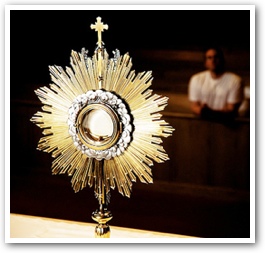Benediction Of The Blessed Sacrament
- FR. WILLIAM SAUNDERS
I recently graduated from college and have relocated to this area to begin work. In my parish there is "Benediction of the Blessed Sacrament every week. I have never seen this before. Could you please explain this ritual?
 |
Unfortunately, the lack of familiarity with exposition and benediction of the Blessed Sacrament is not uncommon these days. I remember when I was "growing up" in the 60s that on special occasions my home parish had exposition and benediction. Then, for whatever reason, this beautiful ritual disappeared. I never remember encountering the practice until I went to the seminary in 1979, where we had exposition and benediction for Sunday Vespers, Wednesday Holy Hours and 40 Hours Devotion. Nevertheless, when I was assigned as a college chaplain, I met several college students who had never witnessed exposition or benediction, or even understood what the terms meant. A sad commentary indeed.
Exposition and benediction of the Blessed Sacrament is not only a very old devotion in our Church, but one that highlights the fundamental mystery of the Holy Eucharist ¾ that our Lord is truly present, body and blood, soul and divinity, in the Blessed Sacrament.
In his holy Thursday letter to priests, "Dominicae cenae" (1980), Pope John Paul II wrote, "Since the Eucharistic mystery was instituted out of love, and makes Christ sacramentally present, it is worthy of thanksgiving and worship. And this worship must be prominent in all our encounters with the Blessed Sacrament" (No. 3).
While emphasizing the importance of the Mass, the Holy Father recommends various forms of Eucharistic devotion: personal prayer and periods of adoration before the Blessed Sacrament, exposition and benediction, Forty Hours devotion, Eucharistic processions, Eucharistic Congresses and a special observance of the Solemnity of Corpus Christi. All of these devotions, which focus on the Blessed Sacrament, aid in out spiritual union with our Lord. As Jesus said, "I Myself am the Bread of Life. No one who comes to Me shall ever be hungry, no one who believes in Me shall ever thirst" (Jn 6:35).
The ritual for exposition and benediction as presented most recently by the Sacred Congregation for Divine Worship (1973) basically follows this ritual: The priest places the Blessed Sacrament in a monstrance or ostensorium on the alter for adoration. (A ciborium containing the Blessed Sacrament may also be used, but the monstrance allows one to view the Holy Eucharist.)
At this time, a hymn of praise (such as "O Salutaris Hostia" ) is sung as the priest incenses the Blessed Sacrament. During the period of adoration, the faithful may pray in quiet and foster a deeper spiritual communion with the Lord. However, the adoration period should also include prayers, such as a novena or Liturgy of the Hours, and readings from Sacred Scripture accompanied by a homily or exhortation to increase the understanding of the Eucharistic mystery.
At the end of the period of adoration, the priest again incenses the Blessed Sacrament as a hymn of praise is sung (such as "Tantum Ergo" ), and then blesses the congregation with the Blessed Sacrament, making the sign of the cross. After the blessing, the priest reposes the Blessed Sacrament in the tabernacle.
This ritual seems to have arisen around the institution of the Feast of Corpus Christi by Pope Urban IV in 1264. On this feast day, the Holy Eucharist was carried in procession in vessels similar to our present day monstrances, which allowed the faithful to view the Blessed Sacrament, Eventually a custom arose, especially in Germany, of keeping the Blessed Sacrament continually exposed to view in all of the churches.
At the same time, members of guilds began to gather to sing canticles in the evening after work in honor of the Blessed Mother. In particular, the singing of the "Salve Regina," composed in the 11th century, became popular in these devotions. These evening services were called "Salat" in France.
Over the next two or three centuries, these two services seem to merge. The faithful would gather, usually in the evening, for chanted prayers, particularly in honor of our Blessed Mother. The Blessed Sacrament would be exposed, more prayers would be chanted or recited, and the service would end with benediction. Interestingly, benediction is still known in France as La Salat. Several parishes in our diocese have exposition and benediction of the Blessed Sacrament weekly in conjunction with novena prayers: Queen of Apostles, St. Lawrence and St. Louis in Alexandria; St. Michael in Annandale, which also has perpetual adoration; St. John in McLean; St. Catherine of Sienna in Great Falls; Our Lady of Lourdes in Arlington; and St. Mary in Fredericksburg.
 This is J. Fraser Field, Founder of CERC. I hope you appreciated this piece. We curate these articles especially for believers like you.
This is J. Fraser Field, Founder of CERC. I hope you appreciated this piece. We curate these articles especially for believers like you.
Please show your appreciation by making a $3 donation. CERC is entirely reader supported.

Acknowledgement
Saunders, Rev. William. "Benediction Of The Blessed Sacrament." Arlington Catholic Herald.
This article is reprinted with permission from Arlington Catholic Herald.
The Author

 Father William Saunders is pastor of Our Lady of Hope parish in Potomac Falls, Virginia. He is dean of the Notre Dame Graduate School of Christendom College. The above article is a "Straight Answers" column he wrote for the Arlington Catholic Herald. Father Saunders is the author of Straight Answers, a book based on 100 of his columns, and Straight Answers II.
Father William Saunders is pastor of Our Lady of Hope parish in Potomac Falls, Virginia. He is dean of the Notre Dame Graduate School of Christendom College. The above article is a "Straight Answers" column he wrote for the Arlington Catholic Herald. Father Saunders is the author of Straight Answers, a book based on 100 of his columns, and Straight Answers II.


